Our second Italian adventure this trip starts where we left off from the first – in Bevagna on our first day in country, many, many hours since our arrival in Italy and many, many more hours since we woke up and began the long trip to Italy. In fact, when we last left you, after filling our stomachs with a grand meal at the even grander restaurant Redibis, it was 11pm at night on our arrival day. We had landed in Rome some 14 hours earlier after flying from Washington, DC some 14 hours before that. Having powered through until 11pm on arrival day is the traveler’s polestar, the sought after but often elusive target of staying awake on the first night, so the body, completely exhausted, will sleep for eight hours uninterrupted, thereby beginning the process of adjusting to local time and, in short, doing as the Romans do.
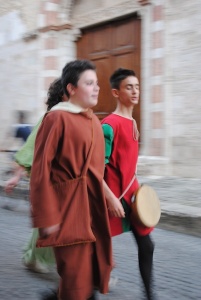 Having had our traditional first lunch at our friend Simone’s le Delizie del Borgo restaurant, having wandered the streets of Bevagna and begun to take in the sights, sounds and smells of its annual Mercato del Gaite medieval festival – the primary reason for our short, two day visit here – and having enjoyed a first rate dinner at Redibis, we should have had enough. Perhaps it was the short nap we wedged in in our comfortable room at the Orto degli Angeli hotel late that afternoon that disturbed the delicate balance, that caused our bodies to tell us that we could and should soldier on. More likely it was the wine consumed in Bevagna’s main Piazza Silvestri before dinner, together with the wine consumed at Redibis, not to mention the short glass of grappa, liquid courage if there ever was such a thing, that made us think that going back to Simone’s for a night cap and to soak in the sights of the festival was a good idea. And perhaps it all was a good idea. We’ll leave that judgment to you.
Having had our traditional first lunch at our friend Simone’s le Delizie del Borgo restaurant, having wandered the streets of Bevagna and begun to take in the sights, sounds and smells of its annual Mercato del Gaite medieval festival – the primary reason for our short, two day visit here – and having enjoyed a first rate dinner at Redibis, we should have had enough. Perhaps it was the short nap we wedged in in our comfortable room at the Orto degli Angeli hotel late that afternoon that disturbed the delicate balance, that caused our bodies to tell us that we could and should soldier on. More likely it was the wine consumed in Bevagna’s main Piazza Silvestri before dinner, together with the wine consumed at Redibis, not to mention the short glass of grappa, liquid courage if there ever was such a thing, that made us think that going back to Simone’s for a night cap and to soak in the sights of the festival was a good idea. And perhaps it all was a good idea. We’ll leave that judgment to you.
* * *
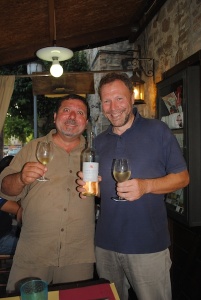
We arrived in the Piazza Garibaldi, the long piazza that is more a widened street than a proper square after the brief two minute walk from Redibis. Piazza Garibaldi, which is flanked on one end by the Porta Cannara or the Cannara Gate and on the other by a Roman temple, is home to several restaurants, among them Antiche Sere, an impossibly tiny restaurant with a small covered wooden porch tacked on the front and which is a favorite haunt of our friend, the internationally acclaimed chef and personality Salvatore Denaro. On the other end of the piazza is Simone’s Delizie del Borgo, with its larger outdoor terrace protruding into the piazza and dominating the entrance to town. To pass into Bevagna from the Porta Cannara, you must pass Simone’s.
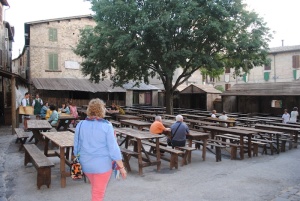 The Mercato del Gaite, or at least as much as we know of it from our 36 hours in Bevagna, is an annual medieval festival. Many if not all of the region’s towns hold summer festivals known as sagre (plural of sagra), which are in effect town block parties that are a reason for the townspeople and visitors to eat and drink together in public places, typically temporary, makeshift structures under tents consisting of picnic tables and a cooking and serving area. The sagra business is big business in Italy during the summer, which is why you will see signs plastered on town walls and on trees throughout the countryside announcing Sagra del Tartufo (Truffle
The Mercato del Gaite, or at least as much as we know of it from our 36 hours in Bevagna, is an annual medieval festival. Many if not all of the region’s towns hold summer festivals known as sagre (plural of sagra), which are in effect town block parties that are a reason for the townspeople and visitors to eat and drink together in public places, typically temporary, makeshift structures under tents consisting of picnic tables and a cooking and serving area. The sagra business is big business in Italy during the summer, which is why you will see signs plastered on town walls and on trees throughout the countryside announcing Sagra del Tartufo (Truffle 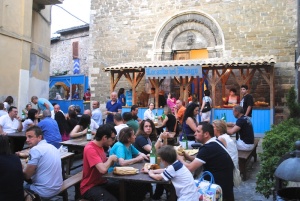 Festival), Sagra del Peperoncino (Hot Pepper Festival), Sagra del’Oca (Festival of the Goose), Sagra della Nutella (Nutella Festival), Sagra delle Lepre (Festival of the Hare) and Sagra della Lumaca (Snail Festival). Typically these food-oriented sagre will highlight the featured food item in a range of dishes, if not all of them, as is the case in our village of Cannara, known throughout Italy for its onions and which holds its Festa della Cipolla (Onion Festival) each September.
Festival), Sagra del Peperoncino (Hot Pepper Festival), Sagra del’Oca (Festival of the Goose), Sagra della Nutella (Nutella Festival), Sagra delle Lepre (Festival of the Hare) and Sagra della Lumaca (Snail Festival). Typically these food-oriented sagre will highlight the featured food item in a range of dishes, if not all of them, as is the case in our village of Cannara, known throughout Italy for its onions and which holds its Festa della Cipolla (Onion Festival) each September.
The Mercato del Gaite is somewhat different, more like the Palio in Siena or the Giostra della Quintana in Foligno. In these towns, the various neighborhoods, quarters, rione, contrade – whatever you decide to call them – compete against one another for bragging rights over some form of contest. In Siena it is a horse race in the main square. In Foligno it is a jousting competition where riders race around a figure eight track on horseback and have to pluck with a jousting pole successively smaller rings suspended from a post. The more bloodthirsty and dangerous, the more potential for injury, accident or homicide, the bigger the crowds the town will get and the more television coverage on RAI 1 or Berlusconi’s television network.
So the Mercato del Gaite is not exactly like the Palio or the Giostra. Being in town for only 36 hours, we never really discovered what the main competition between the town’s four gaite or neighborhoods actually is, but there is one. There was a sort of cooking competition between two of the gaite our first night, but apparently this competition is private, not open to the public and judged by some secret panel. It might be the competition upon which the winner is judged, but we’d rather not believe that Bevagna’s bragging rights are decided in a Betty Crocker cook off.
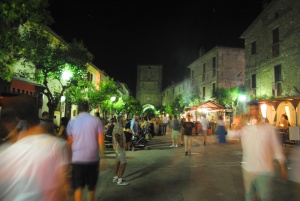 But perhaps that may be the point of the Mercato (and this is complete speculation on my part, as we did not stay long enough to learn the answers). It seems to be a combination between the bloodthirsty Siena-like town competition and the more benign goose festivals. There is food galore. In every quarter of the town there are makeshift taverns set up, with flags and colors of the gaita blazing and people jammed around picnic tables, eating with their hands and washing the food down with local Montefalco wines, being served by young boys and girls in brightly colored medieval costumes representing the gaita. Shops in each neighborhood are made to look oldtimey, with wooden signs placed outside signifiying the trade name in medieval times (aquavit for pubs, aurum for jewelers). The whole town is transformed. Good naturedly, perhaps a bit tongue in cheek. There is not a whole lot of bloodlust apparent on the surface.
But perhaps that may be the point of the Mercato (and this is complete speculation on my part, as we did not stay long enough to learn the answers). It seems to be a combination between the bloodthirsty Siena-like town competition and the more benign goose festivals. There is food galore. In every quarter of the town there are makeshift taverns set up, with flags and colors of the gaita blazing and people jammed around picnic tables, eating with their hands and washing the food down with local Montefalco wines, being served by young boys and girls in brightly colored medieval costumes representing the gaita. Shops in each neighborhood are made to look oldtimey, with wooden signs placed outside signifiying the trade name in medieval times (aquavit for pubs, aurum for jewelers). The whole town is transformed. Good naturedly, perhaps a bit tongue in cheek. There is not a whole lot of bloodlust apparent on the surface.
But at 11pm, after a wee bit too much porchetta and too many drams of aquavit the competitive spirit of the gaite comes out. Or at least it did in the Gaita San Giovanni, the neighborhood that includes Piazza Garibaldi, that includes our hotel the Orto degli Angeli, that includes Simone’s restaurant le Delizie del Borgo. So when 11pm rolled around and we rolled into Piazza Garibaldi rather than rolling into bed on the other side of the gaita, we were swept into a vortex of Bevagna-ness the likes of which we have never seen before.
Perhaps swept into is putting it a bit too strongly. We perhaps paddled a bit ourselves. Before long, in fact, we found ourselves captaining the ship.
* * *
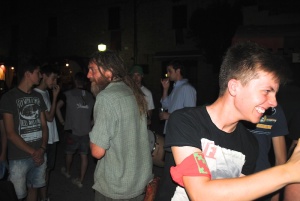 It all started out peacefully enough back at Simone’s. His restaurant was chugging along strongly, even at 11:00 and we joined Simone and his partner Ombretta for a drink, recounting our excellent meal at Redibis and generally catching up with good friends. But the pulse of energy coming from the piazza directly beyond his terrace began, after a while, to mesmerize and to hypnotize. Just beyond the terrace several booths were set up, one grilling skewers of meat, another selling beer and wine, and where there is food and drink, there are sure to be Italians. Sure enough, despite the hour, the crowd continued to build and the energy level, the pulsating energy, the music, the noise continued to draw us in, like a hypnotist’s watch, its soothing rhythm drawing one in until he is oblivious to all outside influences. Or perhaps it was the wine. Or the grappa. Or the jet lag.
It all started out peacefully enough back at Simone’s. His restaurant was chugging along strongly, even at 11:00 and we joined Simone and his partner Ombretta for a drink, recounting our excellent meal at Redibis and generally catching up with good friends. But the pulse of energy coming from the piazza directly beyond his terrace began, after a while, to mesmerize and to hypnotize. Just beyond the terrace several booths were set up, one grilling skewers of meat, another selling beer and wine, and where there is food and drink, there are sure to be Italians. Sure enough, despite the hour, the crowd continued to build and the energy level, the pulsating energy, the music, the noise continued to draw us in, like a hypnotist’s watch, its soothing rhythm drawing one in until he is oblivious to all outside influences. Or perhaps it was the wine. Or the grappa. Or the jet lag.
In any case within a short while we found ourselves off Simone’s patio and in the square, chatting up locals in surprisingly excellent Italian, making friends and learning the secrets of the Mercato. And when I say we, I mean me. A short while later I was sprawled out on the grass in front of the Roman temple having a heart to heart conversation with the local homeless Scotsman. The language difference between us was much greater than with the Italians.
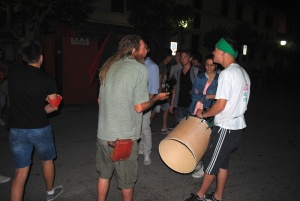 Then the drumming began and the crowd was about to begin its procession from Piazza Garibaldi to the main square, the Piazza Silvestri. Perhaps (and there are some reports suggesting this is true) I was less of a participant than the leader of this procession. In any event it lurched out of Garibaldi on its way to Silvestri well after midnight, dozens of Italians from Gaita San Giovanni, one American and one Scotsman in tow. When the crowd reached the main square there was much dancing and celebrating, perhaps a little speechmaking and a certain amount of fireworking. There was an obligatory encounter with another gaita which had had a similar impulse but fortunately there were no fisticuffs. No fighting, please, we’re Bevanarese. After half an hour the boys and girls from San Giovanni beat their way back to Piazza San Giovanni, together with a police escort, many of whom are now among my closest friends in Bevagna.
Then the drumming began and the crowd was about to begin its procession from Piazza Garibaldi to the main square, the Piazza Silvestri. Perhaps (and there are some reports suggesting this is true) I was less of a participant than the leader of this procession. In any event it lurched out of Garibaldi on its way to Silvestri well after midnight, dozens of Italians from Gaita San Giovanni, one American and one Scotsman in tow. When the crowd reached the main square there was much dancing and celebrating, perhaps a little speechmaking and a certain amount of fireworking. There was an obligatory encounter with another gaita which had had a similar impulse but fortunately there were no fisticuffs. No fighting, please, we’re Bevanarese. After half an hour the boys and girls from San Giovanni beat their way back to Piazza San Giovanni, together with a police escort, many of whom are now among my closest friends in Bevagna.
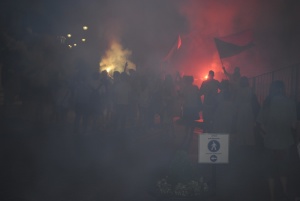 What transpired after that and before our departure around 3am is a bit of blur. Even more so than preceding several hours. All that can be said for certain is that a large group of San Giovanni’s youth took up a cheer before we departed, chanting “Bee-lee, Bee-lee, Bee-lee” before we said our goodnights and goodbyes.
What transpired after that and before our departure around 3am is a bit of blur. Even more so than preceding several hours. All that can be said for certain is that a large group of San Giovanni’s youth took up a cheer before we departed, chanting “Bee-lee, Bee-lee, Bee-lee” before we said our goodnights and goodbyes.
The next morning we awoke in our hotel room, maladjusted to local Italian time and knowing exactly why, just not exactly how. But as we began our final day in Bevagna we knew that neither we nor the Mercato del Gaita would be the same. As we passed through the Piazza Garibaldi on our way to Simone’s for a late morning coffee we were greeted by a number of San Giovanni’s youth greeting “Bee-lee” and asking “dov’e Sooozee?”
Perhaps next year we will return to Bevagna for the Mercato del Gaita and discover just what the main competition entails. Until then, though, we will have our memories, such that they are, to keep us company.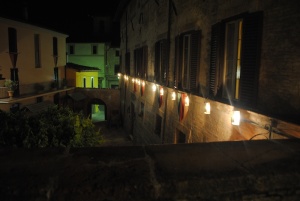
Ci vediamo!
Bill and Suzy
[nggallery id=30]




Comments
About The Author
Related Posts
Lunch at Il Molino
Lunch at the Geribi Studio